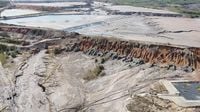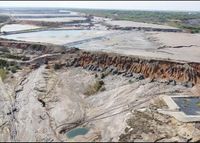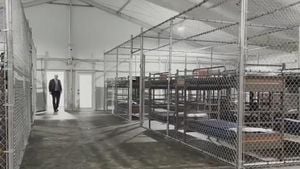In the heart of Zambia’s Copperbelt, a toxic spill from a Chinese-owned mine has ignited fierce debate, international concern, and a $420 million compensation demand from devastated local communities. The disaster, which unfolded on February 18, 2025, when a tailings dam at the Sino-Metals Leach Zambia copper-processing plant near Kitwe collapsed, sent a tidal wave of acidic, metal-laden waste into the Kafue River—a lifeline for millions of Zambians.
According to Bloomberg and the Associated Press, the scale of the catastrophe is staggering. Up to 1.5 million tons of toxic sludge, laced with cyanide, arsenic, copper, zinc, lead, chromium, and cadmium, surged through tributaries connecting to the Zambezi and Kafue rivers. The pollution decimated fish populations, destroyed crops along the riverbanks, and poisoned water sources relied upon by more than half of Zambia’s 21 million people for drinking and irrigation.
In the wake of the spill, two legal groups representing the affected communities issued official letters of demand to Sino-Metals Leach Zambia Ltd., a subsidiary of China Nonferrous Metal Mining Group. As reported by Bloomberg, one group, represented by Malisa & Partners Legal Practitioners, is seeking $220 million to relocate 47 households from the Kalusale community, fund medical screening and treatment, and restore livelihoods destroyed by the disaster. The second group, represented by Malambo & Co., is demanding $200 million to establish an emergency fund for other primarily Kalusale residents. Combined, the claims total a staggering $420 million, underscoring the depth of the crisis and the communities’ urgent need for redress.
The spill’s immediate aftermath was marked by chaos and confusion. The city of Kitwe, home to around 700,000 people, saw its water supply temporarily shut down as authorities scrambled to assess the damage. Zambian President Hakainde Hichilema called the accident a “crisis” and appealed for expert assistance. The government deployed the air force and speedboats to dump hundreds of tons of lime into the contaminated river, hoping to neutralize the acidic waste and stem the environmental damage.
But as the days and weeks passed, the true extent of the disaster became a point of bitter contention. Drizit Environmental, a South Africa-based cleanup company contracted by Sino-Metals to investigate, reported that its two-month probe had uncovered a disaster far more severe than initially disclosed. According to Drizit’s preliminary findings, 1.5 million tons of toxic material—at least 30 times more than Sino-Metals had admitted—were released into the environment. Drizit claimed to have analyzed over 3,500 samples, revealing dangerous concentrations of heavy metals and chemicals capable of causing “significant long-term health risks, including organ damage, birth defects, and cancer.”
Yet, just one day before Drizit was set to deliver its final report, Sino-Metals abruptly terminated the contract, citing “contractual breaches.” The company has since disputed the accuracy of Drizit’s findings and questioned the methodology used to estimate the volume of the spill. The Zambian government announced it would seek a new firm to conduct a fresh investigation, but the lack of transparency has only fueled suspicions among locals and environmental advocates.
By late August, Drizit warned that approximately 900,000 cubic meters—about 238 million gallons—of toxic tailings remained in the environment, posing ongoing risks to people and wildlife. Environmental groups have called the incident one of the largest industrial disasters in Zambia’s history, warning that its consequences could linger for decades.
On the ground, the devastation is all too real. Fish kills have been reported up to 100 kilometers downstream, and farmers along the riverbanks have watched their crops wither in poisoned soil. The contamination has seeped into groundwater, threatening the health and livelihoods of entire communities. The United States Embassy in Zambia, alarmed by “hazardous and carcinogenic substances” detected in the region, issued a health notice and restricted staff travel to the affected area. In August, the embassy went a step further, ordering all U.S. personnel out of the zone near the mine.
Despite mounting evidence and international concern, Zambian authorities have sought to reassure the public. Cornelius Mweetwa, Zambia’s Information and Media Minister, told reporters on September 1, 2025, that the situation was “under control” and that “all serious implications on public health, water safety, agriculture, and the environment have been brought under control; there is therefore no cause for alarm.” Still, many locals and environmental groups remain deeply skeptical, pointing to the sheer volume of toxic waste still unaccounted for and the lack of comprehensive cleanup efforts.
Sino-Metals Leach Zambia has acknowledged receiving the compensation demands but declined to comment further. The company did, however, apologize for the spill and pledged to assist with the cleanup. China’s embassy in Zambia has also recognized the gravity of the situation and defended its companies’ involvement in the country’s mining sector.
The disaster has thrown a harsh spotlight on China’s dominant role in Zambia’s copper mining industry. As one of the world’s top ten copper producers, Zambia is racing to boost output to three million tons per year by 2031, hoping to capitalize on soaring global demand for copper used in electric vehicles and batteries. Chinese investment is central to this push, with China the largest importer of Zambian copper. But the spill has raised uncomfortable questions about environmental oversight, corporate accountability, and the true cost of rapid industrial expansion.
As the legal battle over compensation unfolds, the people of Kalusale and other affected communities are left in limbo—caught between a multinational mining giant, a government eager to project stability, and the slow grind of international scrutiny. Their demands for relocation, medical care, and restored livelihoods are not just about money; they are a plea for justice and a safer future in the shadow of catastrophe.
For now, the toxic legacy of the Chambishi spill remains an open wound on Zambia’s landscape, with its full impact likely to be felt for generations to come.






